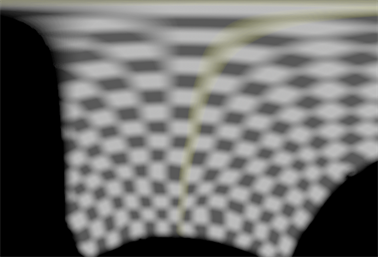Applying LatLong Blur
C_Blur allows you to apply blur to a latlong image and produce a sensible result across the entire frame, as if the blur was applied to a rectilinear image all around.
Certain Nuke nodes only require a single input pixel to produce a corresponding output pixel, for example ColorCorrect, Grade, and so on. These work as expected when applied to latlong material. Other nodes, such as Blur and Defocus, need a tile of pixels around a location to produce a single corresponding output pixel, and do so in a consistent manner across the entire image. If you apply these nodes to a latlong image, the output they produce looks strange when viewed in a headset, because the blur was created in latlong space, rather than in rectilinear.
C_Blur's effect is warped in-line with the view to produce a more natural-looking effect when viewed in rectilinear. The effect is easier to see if you switch the view input to a Checkerboard node. Closer to the equator, both filters produce similar results, but as you move toward the poles, you can see that C_Blur produces a greater effect.
|
|
|
|
Standard Nuke Blur. |
C_Blur. |
C_Blur includes additional controls, Accuracy and Prescale, that represent a trade-off between quality and speed of calculation. The Filter control provides a similar function, Box is the fastest and Gaussian is the smoothest.
• Accuracy - controls the amount of samples used to calculate the blur. Lower values are faster to calculate, but image quality can suffer.
If you're using large C_Blur Size values, you can use Accuracy to reduce processing time with minimal image quality loss.
|
|
|
|
High Accuracy value. |
Low Accuracy value. |
• Prescale - controls the amount of downscaling applied to the image before the blur is applied. Again, lower values are faster to compute, but may introduce banding.
If you're using large C_Blur Size values, you can use Prescale to reduce processing time with minimal image quality loss.
|
|
|
|
High Prescale value. |
Low Prescale value. |






